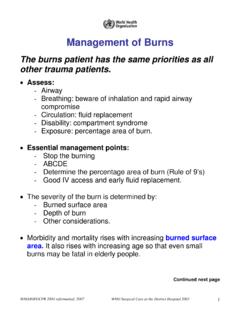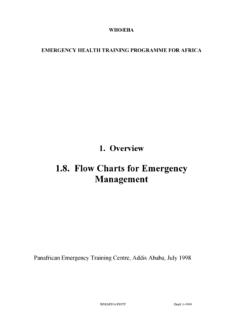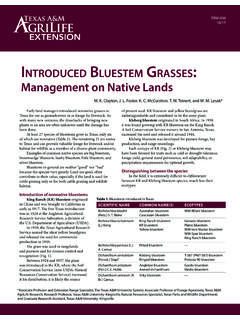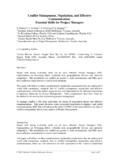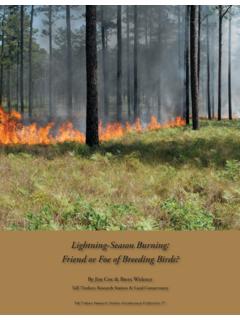Transcription of Nonsurgical Scar Management of the Face: Does Early Versus ...
1 569 Burns to the face and subsequent scarring can lead to one of the most challenging physical and psychologi-cal recoveries for the burn survivor. Studies of adults and children who have survived facial burns show dif-ficult psychological adjustment including increased depression and decreased role 4 Manag-ing facial scarring is also one of the greatest chal-lenges for the burn -care provider. With increasing emphasis in burn research and clinical care on the functional impact of burn injury, facial deformity and its impact on social interactions, role fulfillment, and psychological adjustment must be considered. For this reason, special emphasis is placed on the clinical Management of facial studies describe surgical techniques for managing facial burns while maximizing esthetic outcome,5 8 whereas other studies investigate Nonsurgical , less-invasive Management of hypertro-phic scarring to the 13 Common methods of Nonsurgical Management of facial scars include pres-sure therapy,14 silicone application in combination with pressure or alone,15 massage,16 splinting,10 and facial exercises/range of motion (ROM)11 (Figure 1).
2 Whether scars are located on the face or other body areas, Early Management is a fundamental practice at most burn centers. The recommendation of Early compression to scars for improved results was first reported by Panas17 in 1863 and the philosophy has persisted in clinical practice to date. A study by Leung and Ng18 specifically evaluating the timing of pressure therapy on scars after burn injury found that delayed treatment ( scars treated > 6 months after burn injury) resulted in poorer outcome than those treated with earlier application of pressure. Applied Early in the healing process, silicone gel sheeting has also been reported to be effective in the prevention of hypertrophic Implementation of noninvasive scar Management interventions as Early as possible in the maturation phase of scarring is typically accepted as standard burn rehabilitation purpose of this study was to retrospectively evaluate the timing of common scar Management From Shriners Hospital for Children Northern California, correspondence to Parry I, Shriners Hospital for Children Northern California, 2425 Stockton Boulevard, Sacramento, 2013 by the American burn Association.
3 1559-047X/2013 DOI: emphasis is placed on the clinical Management of facial scarring because of the profound physical and psychological impact of facial burns. Noninvasive methods of facial scar Management include pressure therapy, silicone, massage, and facial exercises. Early implementation of these scar Management techniques after a burn injury is typi-cally accepted as standard burn rehabilitation practice, however, little data exist to support this practice. This study evaluated the timing of common noninvasive scar manage-ment interventions after facial skin grafting in children and the impact on outcome, as measured by scar assessment and need for facial reconstructive surgery. A retrospective review of 138 patients who underwent excision and grafting of the face and subsequent noninvasive scar Management during a 10-year time frame was conducted.
4 Regression analyses were used to show that earlier application of silicone was significantly related to lower Modified Vancouver Scar Scale scores, specifically in the subscales of vascu-larity and pigmentation. Early use of pressure therapy and implementation of facial exercises were also related to lower Modified Vancouver Scar Scale vascularity scores. No relationship was found between timing of the interventions and facial reconstruc-tive outcome. Early use of silicone, pressure therapy, and exercise may improve scar outcome and accelerate time to scar maturity. (J burn Care Res 2013;34:569 575) Nonsurgical Scar Management of the Face: Does Early Versus Late Intervention Affect Outcome?Ingrid Parry, MS, PT, Soman Sen, MD, FACS, Tina Palmieri, MD, FACS, David Greenhalgh MD, FACS Journal of burn Care & Research570 Parry et al September/October 2013interventions after facial grafting in children and its impact on outcome.
5 Our hypothesis was that chil-dren who received earlier noninvasive scar manage-ment intervention (pressure, silicone, massage, or exercise) after acute skin grafting to the face had bet-ter outcomes than those who received later interven-tion. Specifically, we predicted positive relationships between number of days from initiation of inter-vention to Modified Vancouver Scar Scale (MVSS) scores and the need for facial reconstructive retrospective review of medical records was con-ducted on pediatric patients who underwent excision and grafting of the face because of burn injury, at Shriners Hospital for Children Northern Califor-nia between 2000 2010. Charts were reviewed for noninvasive scar Management interventions includ-ing pressure therapy, silicone application, massage, and facial exercise/ROM.
6 This study was approved by the University of California, Davis, Human Sub-jects Review total of 160 patients underwent excision and grafting at our center during the 10-year time period. Twenty-two patients expired, leaving 138 patient charts for review of noninvasive scar man-agement interventions and scar outcome indica-tors. Incomplete documentation required that 56 of those records be excluded, leaving 82 patients for the study. (Figure 2)The time frame for initiation of the four interven-tions after burn injury was recorded. In addition, charts were reviewed for demographic data, burn size or TBSA, and length of hospital stay (LOS).The outcome measures used for this study were 1) MVSS scores20 and 2) the need for facial reconstruc-tive surgery. The MVSS was used clinically over the 10-year period and recorded in the patient s medi-cal record.
7 The scale has four different subscales including vascularity, pigmentation, pliability, and height, and can be scored from 0 to 14 (Table 1).The outcome variable of whether a child underwent later reconstructive surgery was dichotomized and had two options: poor outcome for those patients who required facial reconstructive surgery after their initial grafting and good outcome for those who did range of days to initiation of all four interven-tions were very large for our sample (pressure ther-apy = 11 415; massage = 15 328; silicone = 24 303; and exercise/ROM = 1 546). With a wide range of days to initiation of intervention but relatively few patients per group, we decided to limit the num-ber of scores for the independent variable to bring greater stability to the analyses.
8 Specifically, patients were placed in six categories based on increments of for the range of days within each intervention Figure 1. Common Nonsurgical scar Management interventions. A. Silicone. B Pressure therapy. C. Massage. D. Facial exer-cise (splinting not shown).Figure 2. Medical records excluded or reviewed for the of burn Care & Research Volume 34, Number 5 Parry et al 571group. Six categories were selected to provide a bal-ance between a satisfactory number of observations per category and a sufficient level of variability to test the study hypotheses. Table 2 presents the range of days across the group for each categorical variables representing days to intervention were regressed linearly with MVSS scores. Logistic regression was used to test the rela-tionship between days and the need for facial recon-structive mean age of the patients was (+ ) years, 62% were males.
9 The mean burn size was (+ ) %TBSA and LOS was 68 (+65) days. The majority of patients (73%) were of Hispanic ethnicity, 5% were Caucasian, and 5% were African-American. As seen in Table 3, pressure therapy was used with most patients, followed by massage, silicone, then intervention applied the earliest was massage, whereas silicone was initiated last. Splinting was excluded from the analysis because only one patient underwent splinting of the OutcomeTBSA was significantly associated with MVSS scores and was controlled in the linear regression analy-sis of category days and MVSS scores. It was found from these analyses that later application of silicone was significantly related to higher MVSS scores (Table 4). That is, as number of days to initiation of silicone increase, patients demonstrated poorer outcomes as determined by the rate or extent of change in the subscales of the various versions of the Vancouver Scar Scales have not been well identified, which results in lost or misinterpreted information and scaling issues when using a total or summed scar ,22 Therefore, for this study, analysis was conducted on the indi-vidual subscale scores of the MVSS as well.
10 None of the interventions predicted pliability or height scores. However, when evaluating vascularity, we found that earlier application of silicone, pressure, and exercise were each related to lower vascularity scores and earlier use of silicone to lower pigmenta-tion scores. (Table 5)Reconstructive OutcomeThirty-seven percent of patients did not receive reconstructive surgery and were dichotomized to the good outcome group, whereas 63% under-went reconstruction and were considered poor outcome. Controlling for burn size and LOS, Table 1. Modified Vancouver Scar Scale (Baryza,1995)Pigmentation Normal0 Hypopigmented1 Mixed2 Hyperpigmented3 Pliability Normal0 Supple1 Yielding2 Firm3 Rope-like4 Contracture5 Vascularity Normal0 Pink1 Red2 Purple3 Height Flat0 <2 mm1 2 5 mm2 > 5 mm3 Table 2.
